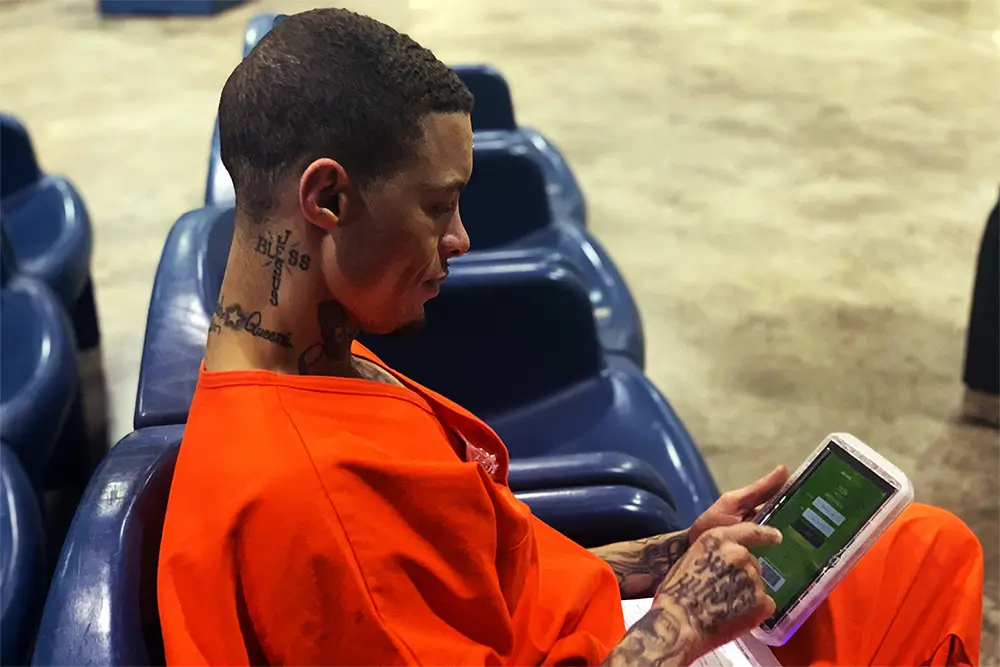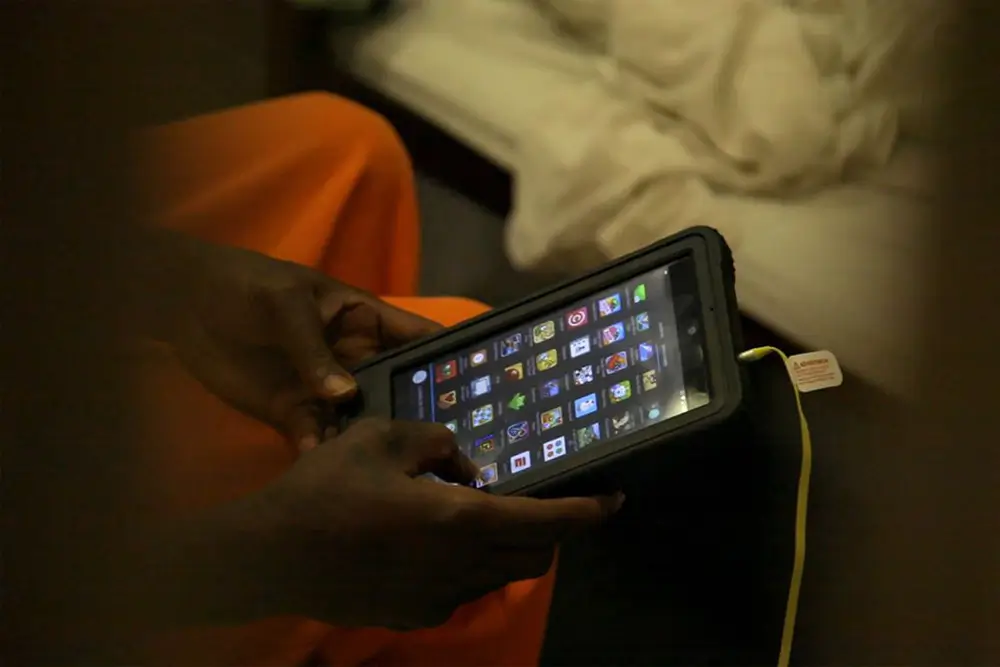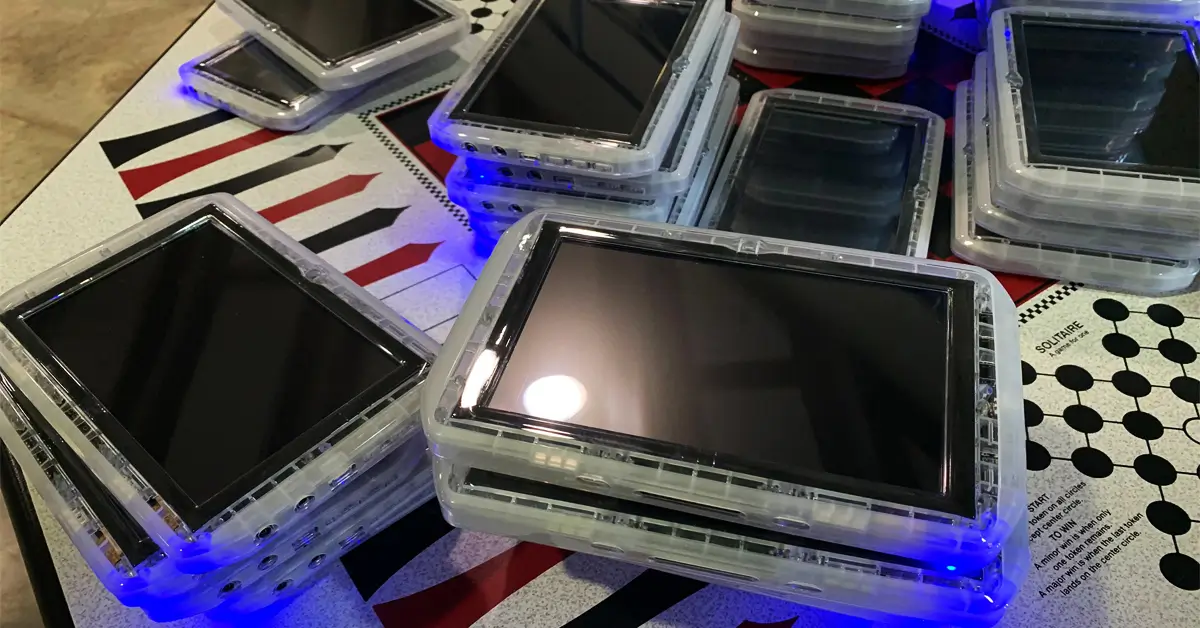Free Prison Tablets Aren’t Free At All
The reason I say “free prison tablets aren’t free” is because they can end up costing more than your private attorney and your commissary combined. My last bid, which was 19 months during the whole Covid Lockdown, which was a friggin’ nightmare like you can’t imagine. But that’s another story for another time. Back to the tablets…
During the 19-month bid one day one of the sergeants steps on the unit and places about 10 GTL (Global Tel Link) tablets on one of the tables and slides off real quick, probably forseeing the drama that was about to pop off. The sergeant leaves 10 tablets for roughly 50 inmates. Now that is what you call a recipe dor disaster. Whoever was awake at that time in the morning grabbed all the tablets and said fuck everybody else. Besides, how are 50 people going to share 10 tablets? They weren’t, that’s how. A few of the bigger guys grabbed 2 or 3 each, which they sold for up to $200.00 to inmates new to the unit via CashApp. About a day after they sold the tablets they would steal them back when the guys who bought them placed them on the wireless charger to recharge. Not only did this lead to countless fights and stabbings, but in the end, because there weren’t enough tablets to go around coupled with the violence that was taking place due to everyone not having their own tablet, the administration yanked all the tablets off every unit. That was the end of the tablets, except for a few inmates who knew the right people or kissed the right CO’s ass, who managed to hold onto a tablet to use once we all locked in. So I finished that 19-month bid at that jail, went to another jail for about a month and discharged March 1, 2022. March 26, 2022 I was back in jail for another year. I know, dickhead shit right? Anyway, Now they’re saying the TV’s that were purchased from commissary will be taken by the administration and “free tablets will be handed to every inmate in the jail”. They began to slowly take a TV here and a TV there from anyone acting up (smoking, fighting, etc.) so we saw the writing on the wall. They did however deliver, as promised, one tablet per inmate. At first we all thought we were livin’ large until we turned them on and saw the “free” applications we could access. A law library app, a bunch of 1.5-3 minute “educational videos”, some outdated PDF books and some religious material. That was it. However, there was a pay-to-play option on these “free” tablets. The games and iHeart Radio streaming service was $0.06 per minute, the movies were between $3.50-$6.00 for 24 hours, e-mails were $0.50 each and phone calls varied between $0.11-$0.27 per minute for domestic calls. The lower priced music streaming music was just random genres of music that costed $0.3 per minute. Some jails had subscription services for the movies and iHeart Radio which varied between $7.99 for 7 days of music or $7.99 for 24 hours of movies. Different jails had different prices. This was all fine and dandy for inmates with money on the books or people on the street looking out, but everybody in the jailhouse doesn’t have money on their books or anyone looking out at all. Which also led to more violence, extortion, and confiscated tablets. The folks who own/run GTL (Global Tel Link) knew exactly what they were doing with those “free” tablets. They knew that anyone inside them walls that had any money would burn up as much money as possible using them tablets. I personally spent between $10-$20 per day religiously on the tablets. That money did not include commissary or phone calls. I was spending between $300-$500 per month. Multiply that times half the inmate population, which is about 800-1000 then multiply that times the hundreds of county, state and federal facilities in the state. Then multiply all the combined jails & prisons in the state by 50 states. The money they must take in is ridiculous. I know GTL pays between $800,000.00 and $1.5 million to each state they have tablets in the prison system in. They have a confined customer bas that’s willing to pay money just to use many apps that are free to use on the street. It’s disgusting if you ask me. Below is a story I found on the ‘net that details the ins & outs of how they legally rob inmates currently incarcerated. In early March 2020, when COVID-19 infections began spreading in U.S. correctional facilities, Roger found himself serving the final months of a fifteen-year sentence in Eastern Correctional Facility, a maximum-security prison in Ulster County, located about one hundred miles north of New York City. As the virus took hold, the prison implemented strict measures: movement was restricted, recreation areas closed, and visitations and educational programs were suspended. Roger described the situation, saying, “we were literally locked in our cells, as if we were in solitary confinement.” Amidst these challenging circumstances, Roger considered himself fortunate to have received a “mini-tablet” through a contract New York had signed with JPay, a subsidiary of the prison telecommunication giant Securus Technologies, in 2017. The tablet was provided to incarcerated individuals like Roger at no upfront cost. However, there was a catch: while the tablets offered access to email, music, e-books, and games, these services came with significant price tags. JPay expected the profits from associated fees to exceed the cost of providing the tablets for free. The New York State Department of Corrections projected a net profit of approximately $8.8 million by August 2022, with around 50,000 incarcerated individuals set to receive tablets in prisons across the state. New York was not alone in implementing a prison tablet program. Between 2017 and 2019, at least eleven other states entered into contracts with prison telecommunications companies such as Securus and GTL. Corporate spokespeople and corrections officials touted the tablets as a means to provide hundreds of thousands of incarcerated people across the country with access to communication, information, and entertainment. When Ohio introduced a tablet program, a spokeswoman for the Ohio Department of Rehabilitation and Correction expressed hope that it would serve as a valuable educational tool. However, the reality is that the proliferation of prison tablets aligns with the larger pattern of predatory corporations exploiting incarcerated individuals and profiting from a captive market. Over the past four decades, as the national prison population has soared, corrections systems have consistently underfunded programs, services, and essential goods. Instead, corrections officials have outsourced these responsibilities to private corporations, effectively turning prison services into a multibillion-dollar retail industry. Incarcerated individuals are compelled to purchase additional food, clothing, hygiene products, and other goods from external vendors who charge exorbitant rates for basic services like phone calls, money transfers, and commissary transactions. Juan, who spent nearly a decade in New York state prisons, emphasized the financial burden of incarceration, saying, “When you go to jail you think, yeah, I got three meals, I got a shower and everything. [But] it’s not as easy as it sounds. Prison is expensive. You need money to live in there.” With average prison labor wages stagnating at less than $0.40 per hour, most incarcerated individuals rely on financial support from friends and family. However, these remittances often impose a heavy financial strain on the families of the incarcerated. According to a 2017 Prison Policy Initiative report, families spend billions of dollars each year covering the costs of phone calls and commissary purchases for their loved ones behind bars. The COVID-19 pandemic further exacerbated this burden. As mass layoffs swept across the United States in 2020, the flow of money into prisons dwindled. Michael, who was in the final months of a two-year sentence in Connecticut when correctional facilities went into lockdown, explained, “A lot of people weren’t getting financial support anymore. Their people [outside] were dying or were losing money.” With commissary accounts running dry and institutions grappling with their own supply problems, panic spread within the New York prison where Roger was housed. Roger recalled the fear that they would be abandoned and left to die in prison, locked in their cells. In response to this disruption, informal lenders within the prison economy, known as “jugglers,” began charging double the usual rates. Many institutions imposed strict limits on commissary purchases. At Fishkill, a medium-security facility in New York’s Hudson Valley, food sales were restricted, including staples like pasta, rice, and soups, as Carlos, who was nearing the end of a ten-year sentence, revealed. Some prisons even halted or slowed down the processing of mail and packages, which often contained food, citing staff shortages. When families on the outside learned about these dynamics, sending money to their incarcerated loved ones became an even higher priority. Fred, who worked at a restaurant in Queens when the pandemic hit, experienced the strain of not being able to visit his son, who had been incarcerated since 2018. Fred made sure to match his regular monthly contributions toward his son’s commissary and phone accounts, even though he was laid off in the early weeks of the pandemic and fell into debt to continue supporting his son while paying his own bills. By late April 2021, Fred still owed over $10,000, mostly to friends and family. Lavern, who lived in Long Island with her daughter, had her boyfriend incarcerated since 2019. She mentioned that the emotional toll of not being able to see her loved one for extended periods of time was exacerbated by the financial strain. As her income decreased due to reduced work hours caused by school closures, the costs of her boyfriend’s phone calls and commissary expenses increased. Without in-person visits, their phone calls became longer and more frequent. Lavern estimated that she spent over $600 per month supporting her boyfriend during the first year of the pandemic, considering expenses for phone calls, emails, and commissary items. All of these financial transactions were made possible through the software, tablets, and profit-driven motives of prison telecommunications giants. In 2012, JPay introduced prison tablets, allowing incarcerated individuals to purchase devices for $140. These tablets, running on a modified version of Android, do not have direct access to the internet. Instead, users must connect them to designated “kiosks” within the prison to download music, videos, and send emails. In 2015, Securus, a prison telecommunications company, acquired JPay, which had already gained substantial profits from phone services in prisons and jails across the United States. The acquisition was seen as a strategic move by Securus to diversify its offerings and tap into the growing segments of payments, email, and inmate tablets. JPay and its main competitor, GTL, signed lucrative contracts with several states between 2017 and 2019 to distribute tablets to incarcerated populations. Both companies eventually decided to provide the tablets for free. However, they imposed charges at every step of the communication process. In New York, for example, each email sent or received required a “stamp” that cost $0.25, with additional charges for longer messages, pictures, or cards. Video-grams could be sent for four stamps. Furthermore, JPay charged exorbitant fees for downloading music, movies, e-books, and games. State records indicated that songs could cost up to $2.50 each, with albums priced at up to $46. Movie rentals ranged from $2 to $25. Initially, JPay even sold e-books sourced from Project Gutenberg, a free book database, but faced public pressure and ceased the practice in November 2019. Despite the high costs, tablets became highly sought after within prisons, especially among younger incarcerated individuals. During the COVID-19 pandemic, when prison activities were halted, the appeal of tablets grew even stronger. Incarcerated individuals relied on them for entertainment and connecting with loved ones outside. The expenses associated with tablet usage skyrocketed, with some individuals and their families accumulating monthly bills as high as $1,000. While JPay offered temporary discounts and promotions during the pandemic, such as reduced prices on movies and songs and “free-reply Wednesdays” for emails, the quality of the free content was often considered subpar. Nevertheless, many incarcerated individuals felt compelled to purchase these services to maintain a sense of normalcy and avoid conflicts with others. Roger and other sources emphasized that JPay recognized the captive consumer base within prisons, acknowledging that incarcerated individuals had no choice but to buy their products. Despite requests for comment, JPay did not respond. According to legal scholar Hadar Aviram, the neoliberal prison model has shifted the perception of prisoners from “wards of the state” to “consumers of institutional services.” The ongoing pandemic has accelerated this transformation, with technology playing an increasingly significant role in the lives of incarcerated individuals. However, prison telecom companies envision tablets not as tools for education and rehabilitation, as they claim, but rather as exploitative devices that offer subpar services at exorbitant prices. Several examples already demonstrate what this “high-tech” prison system could entail. Prisons in Pennsylvania, Florida, and other states have replaced physical mail with email and digital copies due to the availability of tablets and concerns about contraband. Some facilities have even replaced in-person visits with paid video calls, making tablets the sole means of contact between prisoners and their loved ones. Privatization has been touted as a way to alleviate the financial burden on public budgets. However, for incarcerated individuals and their families, this shift has resulted in an increased financial burden for life’s basic necessities. Companies like JPay and GTL capitalize on incarcerated individuals and their families by extracting more money from them, exacerbating the negative economic impact of imprisonment and diverting resources that could otherwise support loved ones post-incarceration. Fortunately, some lawmakers have started to recognize this issue. In July 2018, the New York City Council passed legislation to make phone calls from the city’s jails free, prohibiting the collection of revenues from phone services. Connecticut followed suit in 2021, becoming the first state to provide all incarcerated individuals with a minimum of ninety minutes of free calls each day. This change aims to address the regressive policy that unnecessarily burdens families and perpetuates the cycle of recidivism. As JPay’s contracts with various states approach expiration, including New York, Maine, and Indiana, advocates see an opportunity to build on these victories. The goal is to establish a technology infrastructure that serves the needs of incarcerated users rather than exploiting them and their families. Katy Ryan, the founder of the Appalachian Prison Book Project, suggests that tablets, under fair terms, could be beneficial within prisons. However, if prison telecommunications companies like JPay continue their current exploitative direction, there is little reason to believe that these devices will have a positive impact.Nothing Is Free In Jail
The Covid Lockdown
A “Valuable Education Tool” They called It

The Prison Economy
Tablets With No Real Internet Access
Tablets Were Hot Commodities Regardless Of Cost

High-Tech Prison Failures




